Experimental Study on the Enhancement of Pool Boiling Heat Transfer Characteristics of Water-Based Nanofluids with Graphene Nanoplatelets on Nichrome Wire
Abstract
1. Introduction
2. Materials and Methods
2.1. Selection of Base Fluid and Nanomaterial
2.2. Functionalization and Characterization of GnP
2.3. Preparation and Stability of Nanofluids
2.4. Measurements of Thermo-Physical Characteristics
2.5. Fabricated Test Facility for Exploratory Analysis
2.6. Process of Exploratory Analysis
3. Data Reduction
4. Uncertainty
5. Results and Discussion
5.1. Heat Flux vs. Excess Temperature for Various Volume Concentrations
5.2. Boiling Heat Transfer Coefficient
5.3. SEM Visualization of Nichrome Wire After the Boiling of dH2O and f-GnP-dH2O Nanofluids
6. Summary and Conclusions
- The f-GnP–dH2O nanofluids with various vol% were characterized by measuring zeta potential distribution and pH to ensure stability on day 1 and day 10 following preparation.
- The results show zeta potential values ranging from −31.6 mV to −30.6 mV and pH values ranging from 7.076 to 7.021 between day 1 and day 10, respectively, which confirm the good stability of f-GnP–dH2O nanofluids.
- The average increments in heat flux were found to be ~60% when the ΔT increased from 1 °C to 200 °C, while it was found to be ~90% when the ΔT increased from 200 °C to 1400 °C at a critical point. The maximum enhancements in critical heat flux were observed to be ~15% before the transition boiling region and ~24% at the burnout point of the Ni-Cr test wire in the film boiling region at 0.1 vol%, respectively, compared to dH2O.
- A significant 13.39% increment of up to 0.075 vol% in CHF was observed with the addition of f-GnP to dH2O, while smaller enhancements of ~ 2.5% were observed after the successive addition of 0.025% in dH2O.
- The average decrement in the BHTC was found to be in the range of ~40% to ~90% for every increase in 200 kW/m2 heat flux. Initially, the BHTC decreased from ~10% to ~60% when the vol% of f-GnP increased from 0% to 0.01%, while the decrement increased by up to 25% when the vol% increased from 0 to 0.025%.
- The maximum increment in BHTC was found to be ~12% at a 0.1 vol% of f-GnP–dH2O nanofluid.
- The SEM results show higher roughness on the surface of the Ni-Cr test wire with the heating of pure base fluid, while lower roughness was found with the heating of nanofluids.
7. Scope for Future Works
Author Contributions
Funding
Data Availability Statement
Acknowledgments
Conflicts of Interest
Nomenclature
| Nomenclature | |
| A | Area (m2) |
| k | Thermal conductivity (W/mK) |
| I | Current (A) |
| V | Voltage (V) |
| T | Temperature (°C) |
| q | Heat flux (W/m2) |
| Abbreviations | |
| BHTC | Boiling Heat Transfer Coefficient (Wm−2K−1) |
| CHF | Critical Heat Flux (W/m2) |
| Cu | Copper |
| CuO | Copper Oxide |
| CNT | Carbon Nanotube |
| GO | Graphene Oxide |
| GnP | Graphene Nanoplatelet |
| f-GnP | Functionalized Graphene Nanoplatelet |
| Ni-Cr | Nichrome |
| r-GO | Reduced Graphene Oxide |
| SEM | Scanning Electron Microscopy |
| SDS | Sodium dodecyl Sulfate |
| PEG | Polyethylene Glycol |
| Si | Silica |
| Greek letters | |
| Δ | Temperature difference (°C) |
| ΔT | Excess temperature (°C) |
| Subscript | |
| H2O | Water |
| dH2O | Distilled water |
| DI-H2O | Deionised water |
| Al2O3 | Alumina |
| Vol% | Volume concentration |
| Wire resistance | |
| Typical system resistance | |
| Actual system resistance | |
| Baseline resistance | |
| Tw | Wire temperature (°C) |
| Tb | Baseline temperature (°C) |
References
- Bergles, A.E. High flux boiling applied to microelectronics thermal control. Int. Commun. Heat Mass Transf. 1988, 15, 509–531. [Google Scholar] [CrossRef]
- Sadeghinezhad, E.; Mehrali, M.; Rosen, M.A.; Akhiani, A.R.; Latibari, S.T.; Mehrali, M.; Metselaar, H.S. Experimental investigation of the effect of graphene nanofluids on heat pipe thermal performance. Appl. Therm. Eng. 2016, 100, 775–787. [Google Scholar] [CrossRef]
- Tang, K.; Jia, M.; Zhong, G.; Chen, S.; Zhang, S.; Yuan, W.; Chen, G. Pool boiling heat transfer of dual-scale porous microchannel for high-power electronics cooling. Int. Commun. Heat Mass Transf. 2022, 138, 106339. [Google Scholar] [CrossRef]
- Pingale, A.D.; Katarkar, A.S.; Madgule, M.; Bhaumik, S.; Belgamwar, S.U. An experimental investigation on the pool boiling heat transfer of R-134a on microporous Cu-MWCNT composite surfaces. Thermo 2024, 4, 16–28. [Google Scholar] [CrossRef]
- Díaz, J.; Prieto, M.M.; Fernández, F.J.; Castro-García, M.P. Revisiting Nukiyama’s Experiment to Enhance Understanding of Boiling Heat Transfer. Educ. Chem. Eng. 2025, 53, 80–90. [Google Scholar] [CrossRef]
- Saidur, R.; Leong, K.Y.; Mohammed, H.A. A review on applications and challenges of nanofluids. Renew. Sustain. Energy Rev. 2011, 15, 1646–1668. [Google Scholar] [CrossRef]
- Wen, D.; Corr, M.; Hu, X.; Lin, G. Boiling heat transfer of nanofluids: The effect of heating surface modification. Int. J. Therm. Sci. 2011, 50, 480–485. [Google Scholar] [CrossRef]
- Yu, W.; Xie, H. A review on nanofluids: Preparation, stability mechanisms, and applications. J. Nanomater. 2012, 2012, 435873. [Google Scholar] [CrossRef]
- Kole, M.; Dey, T.K. Investigations on the pool boiling heat transfer and critical heat flux of ZnO-ethylene glycol nanofluids. Appl. Therm. Eng. 2012, 37, 112–119. [Google Scholar] [CrossRef]
- Sheikhbahai, M.; Esfahany, M.N.; Etesami, N. Experimental investigation of pool boiling of Fe3O4/ethylene glycol–water nanofluid in electric field. Int. J. Therm. Sci. 2012, 62, 149–153. [Google Scholar] [CrossRef]
- Khan, A.; Ali, H.M. A comprehensive review on pool boiling heat transfer using nanofluids. Therm. Sci. 2019, 23 Pt B, 3209–3237. [Google Scholar] [CrossRef]
- Kumar, M.D.; Raju, C.S.; Ashraf, H.; Shah, N.A.; Ali, A.; Mennouni, A.; Muhammad, N.; Wakif, A.; Ramesh, K.; Vaidya, H.; et al. Analysis of dynamical assisting and opposing flow characteristics of darcy surface-filled ternary nanoparticles and fourier flux: Artificial neural network and levenberg method. J. Circuits Syst. Comput. 2024, 33, 2440001. [Google Scholar] [CrossRef]
- Vassallo, P.; Kumar, R.; D’Amico, S. Pool boiling heat transfer experiments in silica–water nano-fluids. Int. J. Heat Mass Transf. 2004, 47, 407–411. [Google Scholar] [CrossRef]
- Bang, I.C.; Chang, S.H. Boiling heat transfer performance and phenomena of Al2O3–water nano-fluids from a plain surface in a pool. Int. J. Heat Mass Transf. 2005, 48, 2407–2419. [Google Scholar] [CrossRef]
- Kathiravan, R.; Kumar, R.; Gupta, A.; Chandra, R. Preparation and pool boiling characteristics of copper nanofluids over a flat plate heater. Int. J. Heat Mass Transf. 2010, 53, 1673–1681. [Google Scholar] [CrossRef]
- Yagnem, A.R.; Venkatachalapathy, S. Heat transfer enhancement studies in pool boiling using hybrid nanofluids. Thermochim. Acta 2019, 672, 93–100. [Google Scholar] [CrossRef]
- Milanova, D.; Kumar, R. Heat transfer behavior of silica nanoparticles in pool boiling experiment. J. Heat Transf. 2008, 130, 042401. [Google Scholar] [CrossRef]
- Song, S.L.; Lee, J.H.; Chang, S.H. CHF enhancement of SiC nanofluid in pool boiling experiment. Exp. Therm. Fluid Sci. 2014, 52, 12–18. [Google Scholar] [CrossRef]
- Ajeeb, W.; Murshed, S.S. Pool boiling heat transfer characteristics of new and recycled alumina nanofluids. Nanomaterials 2023, 13, 1040. [Google Scholar] [CrossRef]
- Kamatchi, R.; Venkatachalapathy, S. Parametric study of pool boiling heat transfer with nanofluids for the enhancement of critical heat flux: A review. Int. J. Therm. Sci. 2015, 87, 228–240. [Google Scholar] [CrossRef]
- Akbari, A.; Alavi Fazel, S.A.; Maghsoodi, S.; Kootenaei, A.S. Pool boiling heat transfer characteristics of graphene-based aqueous nanofluids. J. Therm. Anal. Calorim. 2019, 135, 697–711. [Google Scholar] [CrossRef]
- Akbari, A.; Mohammadian, E.; Alavi Fazel, S.A.; Shanbedi, M.; Bahreini, M.; Heidari, M.; Ahmadi, G. Comparison between nucleate pool boiling heat transfer of graphene nanoplatelet-and carbon nanotube-based aqueous nanofluids. ACS Omega 2019, 4, 19183–19192. [Google Scholar] [CrossRef] [PubMed]
- Singh, S.K.; Sharma, D. Pool boiling experiments in graphene, graphene oxide and reduced graphene oxide nanofluid. Heat Transf. Eng. 2025, 1–20. [Google Scholar] [CrossRef]
- Shaafi, A.; Zaboli, S.; Alimoradi, H.; Shams, M. Numerical investigation of surface wettability effects on pool boiling properties of different nanofluids. Case Stud. Therm. Eng. 2025, 71, 106142. [Google Scholar] [CrossRef]
- Sarsam, W.S.; Amiri, A.; Kazi, S.N.; Badarudin, A. Stability and thermophysical properties of non-covalently functionalized graphene nanoplatelets nanofluids. Energy Convers. Manag. 2016, 116, 101–111. [Google Scholar] [CrossRef]
- Kamatchi, R.; Kumaresan, G. Investigations on pool boiling critical heat flux, transient characteristics and bonding strength of heater wire with aqua-based reduced graphene oxide nanofluids. Chin. J. Chem. Eng. 2018, 26, 445–454. [Google Scholar] [CrossRef]
- Borode, A.O.; Ahmed, N.A.; Olubambi, P.A.; Sharifpur, M.; Meyer, J.P. Effect of various surfactants on the viscosity, thermal and electrical conductivity of graphene nanoplatelets Nanofluid. Int. J. Thermophys. 2021, 42, 158. [Google Scholar] [CrossRef]
- Balaji, T.; Selvam, C.; Lal, D.M.; Harish, S. Enhanced heat transport behavior of micro channel heat sink with graphene-based nanofluids. Int. Commun. Heat Mass Transf. 2020, 117, 104716. [Google Scholar] [CrossRef]
- Sidney, S.; Dhasan, M.L.C.S.; Harish, S. Experimental investigation of freezing and melting characteristics of graphene-based phase change nanocomposite for cold thermal energy storage applications. Appl. Sci. 2019, 9, 1099. [Google Scholar] [CrossRef]
- Balaji, T.; Rajendiran, S.; Selvam, C.; Lal, D.M. Enhanced heat transfer characteristics of water based hybrid nanofluids with graphene nanoplatelets and multi walled carbon nanotubes. Powder Technol. 2021, 394, 1141–1157. [Google Scholar] [CrossRef]
- Hyndman Industrial Products, Inc. Resistance Wire Heating Data. Available online: www.resistancewire.com (accessed on 5 June 2025).
- Zafar, S.; Adil, M.; Azhar, M.; Siddiqui, M.A. Experimental and numerical study of Pool boiling and critical heat flux enhancement using water-based silica Nanofluids. Heat Mass Transf. 2021, 57, 1593–1607. [Google Scholar] [CrossRef]
- Sivashankar, M.; Selvam, C.; Suresh, S. Experimental study on the performance of low concentrated solar photovoltaic system with nano-enhanced phase change material encapsulated heat sink. Appl. Therm. Eng. 2025, 262, 125254. [Google Scholar] [CrossRef]
- Nukiyama, S. The maximum and minimum values of the heat Q transmitted from metal to boiling water under atmospheric pressure. Int. J. Heat Mass Transf. 1966, 9, 1419–1433. [Google Scholar] [CrossRef]
- Kathiravan, R.; Kumar, R.; Gupta, A.; Chandra, R. Characterization and pool boiling heat transfer studies of nanofluids. J. Heat Transf. 2009, 131, 081902. [Google Scholar] [CrossRef]
- Huang, M.; Borzoei, H.; Abdollahi, A.; Li, Z.; Karimipour, A. Effect of concentration and sedimentation on boiling heat transfer coefficient of GNPs-SiO2/deionized water hybrid Nanofluid: An experimental investigation. Int. Commun. Heat Mass Transf. 2021, 122, 105141. [Google Scholar] [CrossRef]
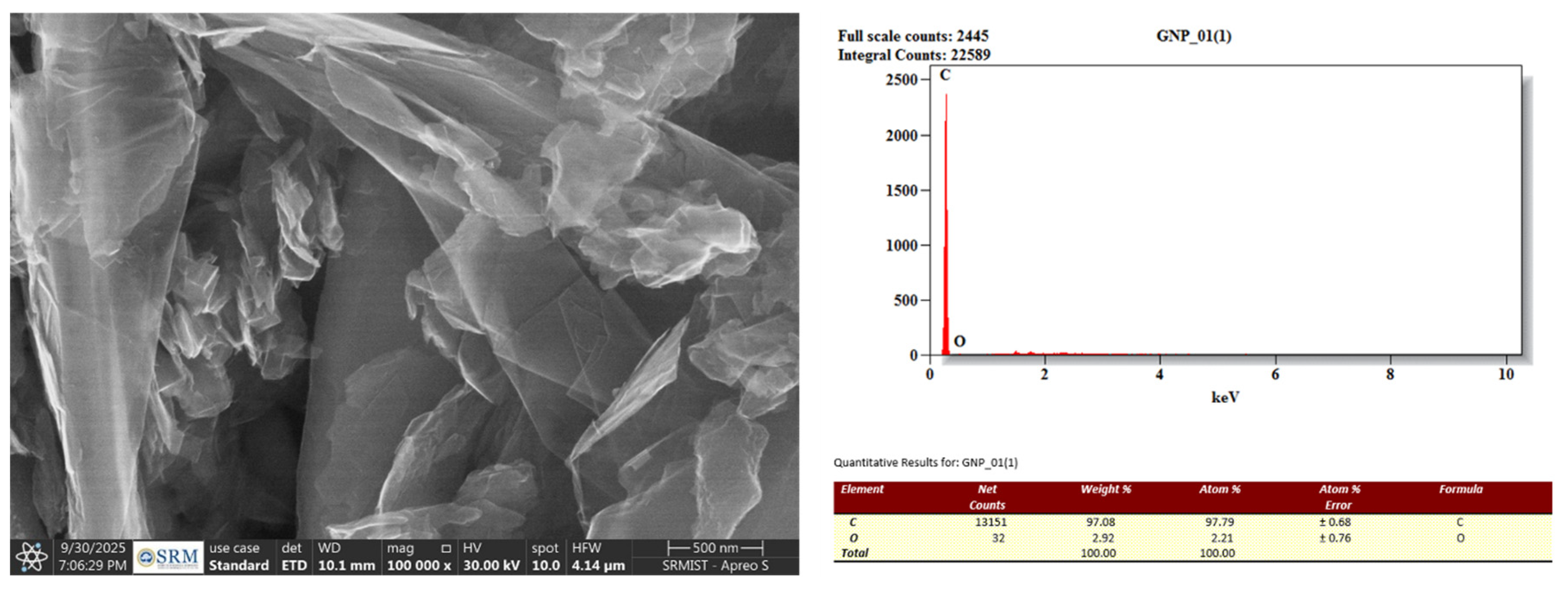
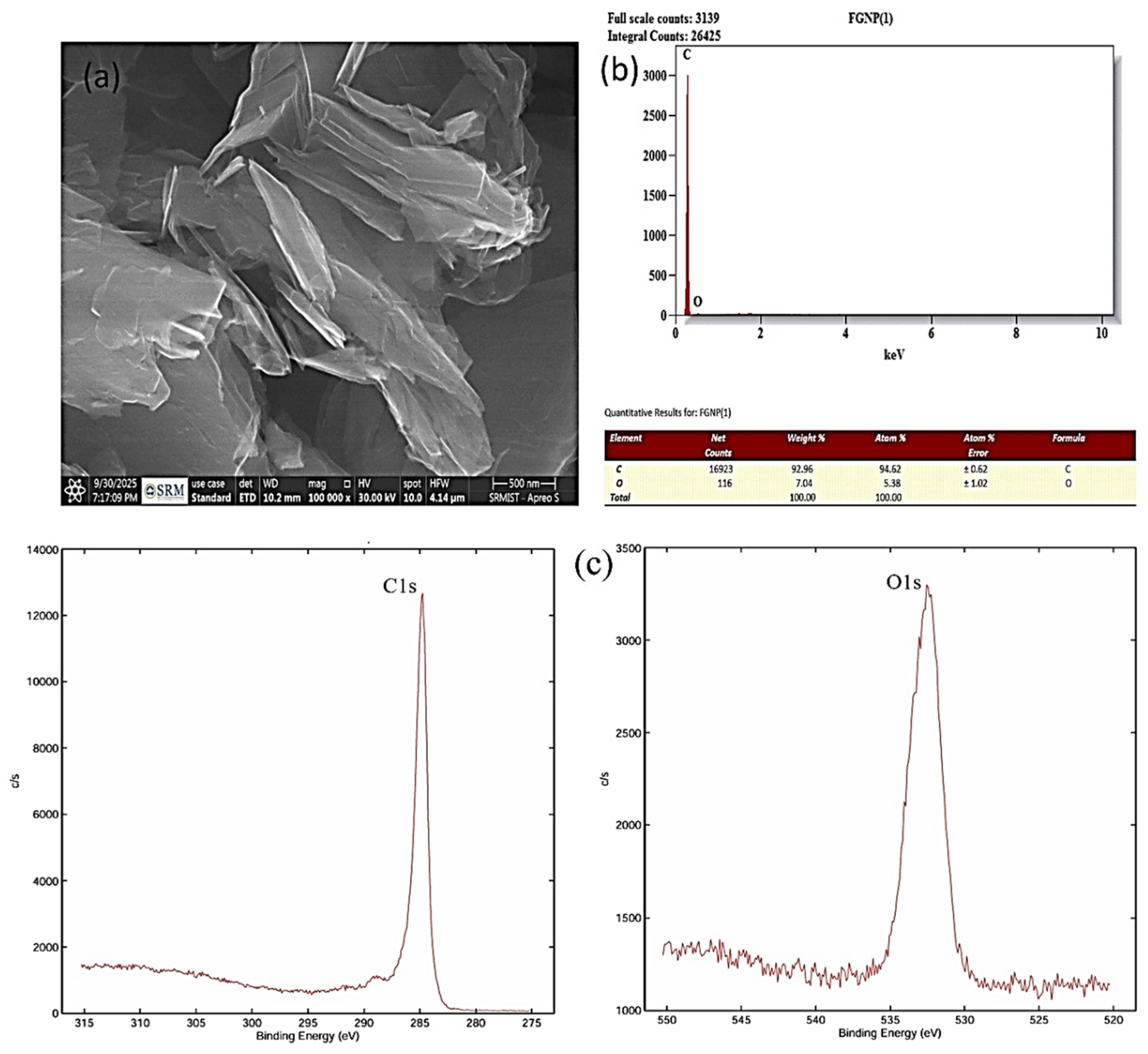
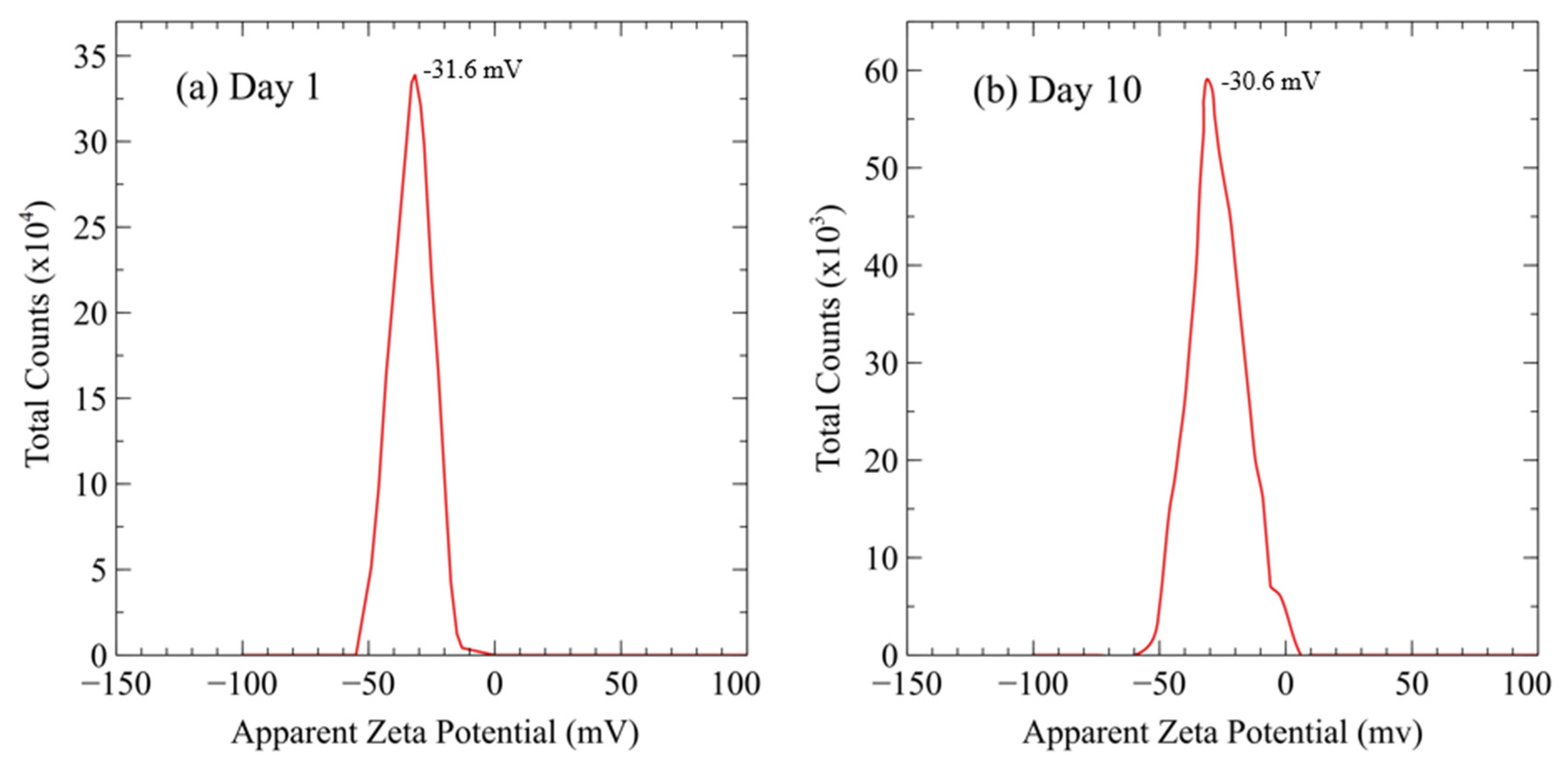


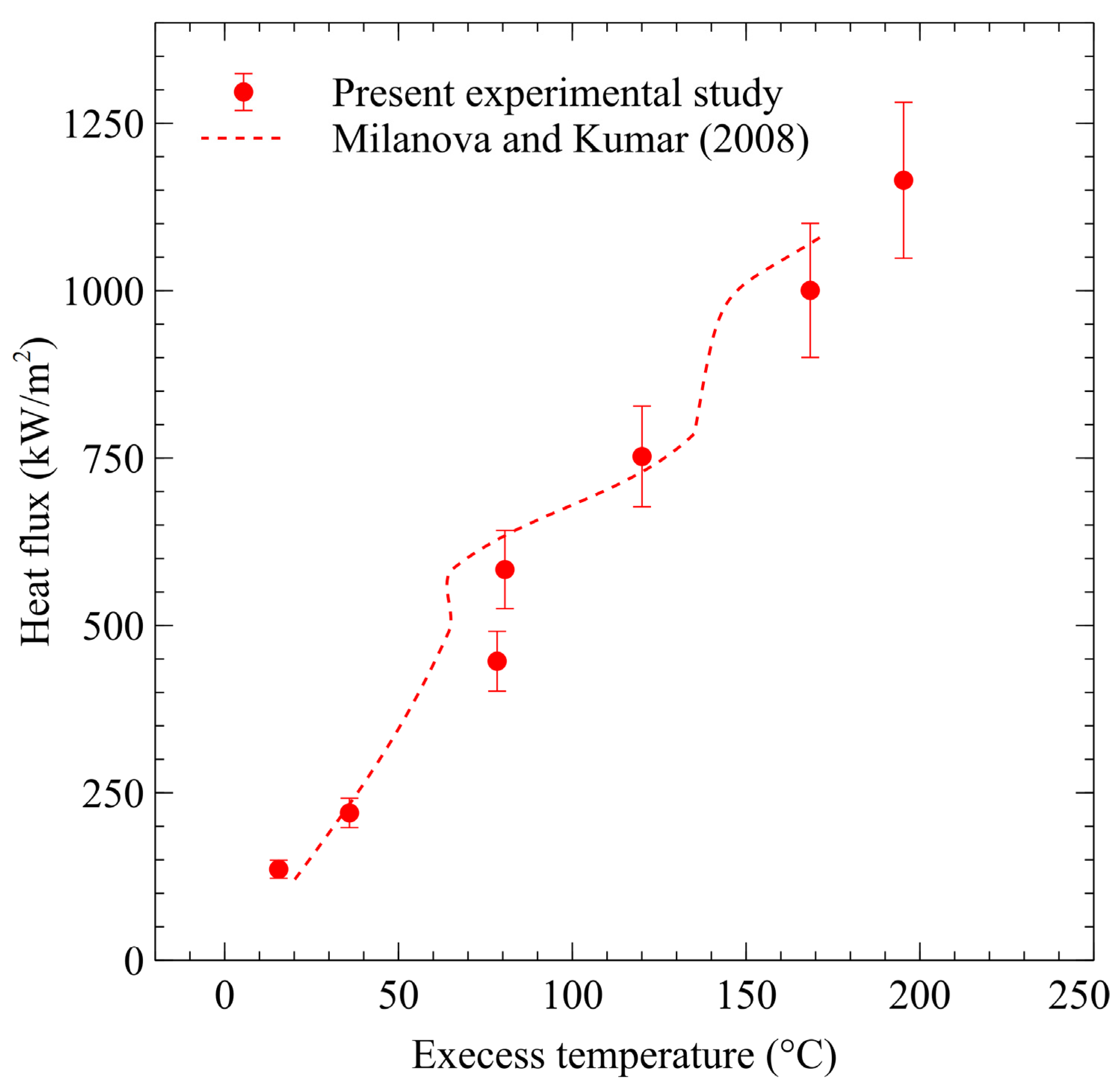
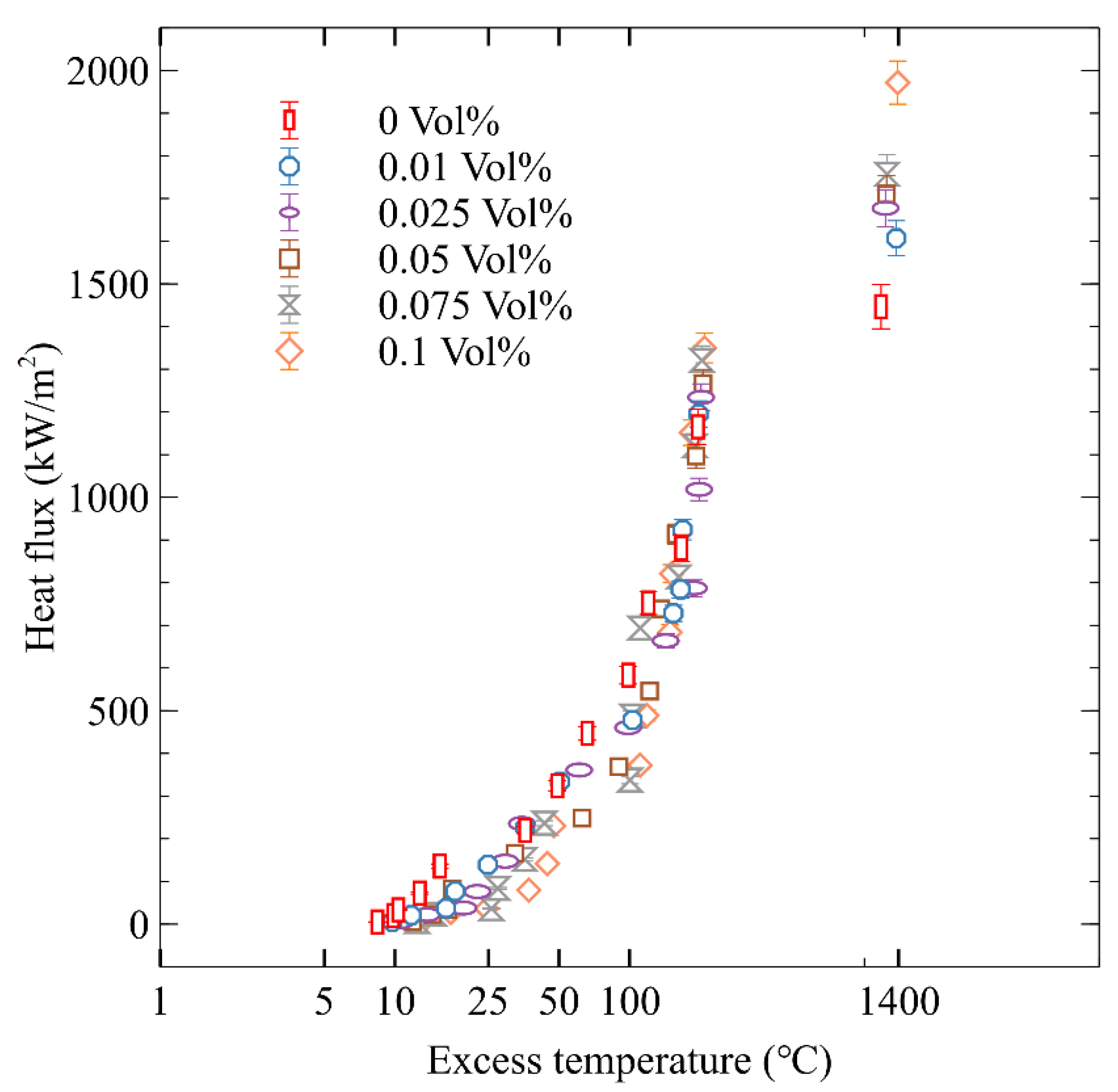
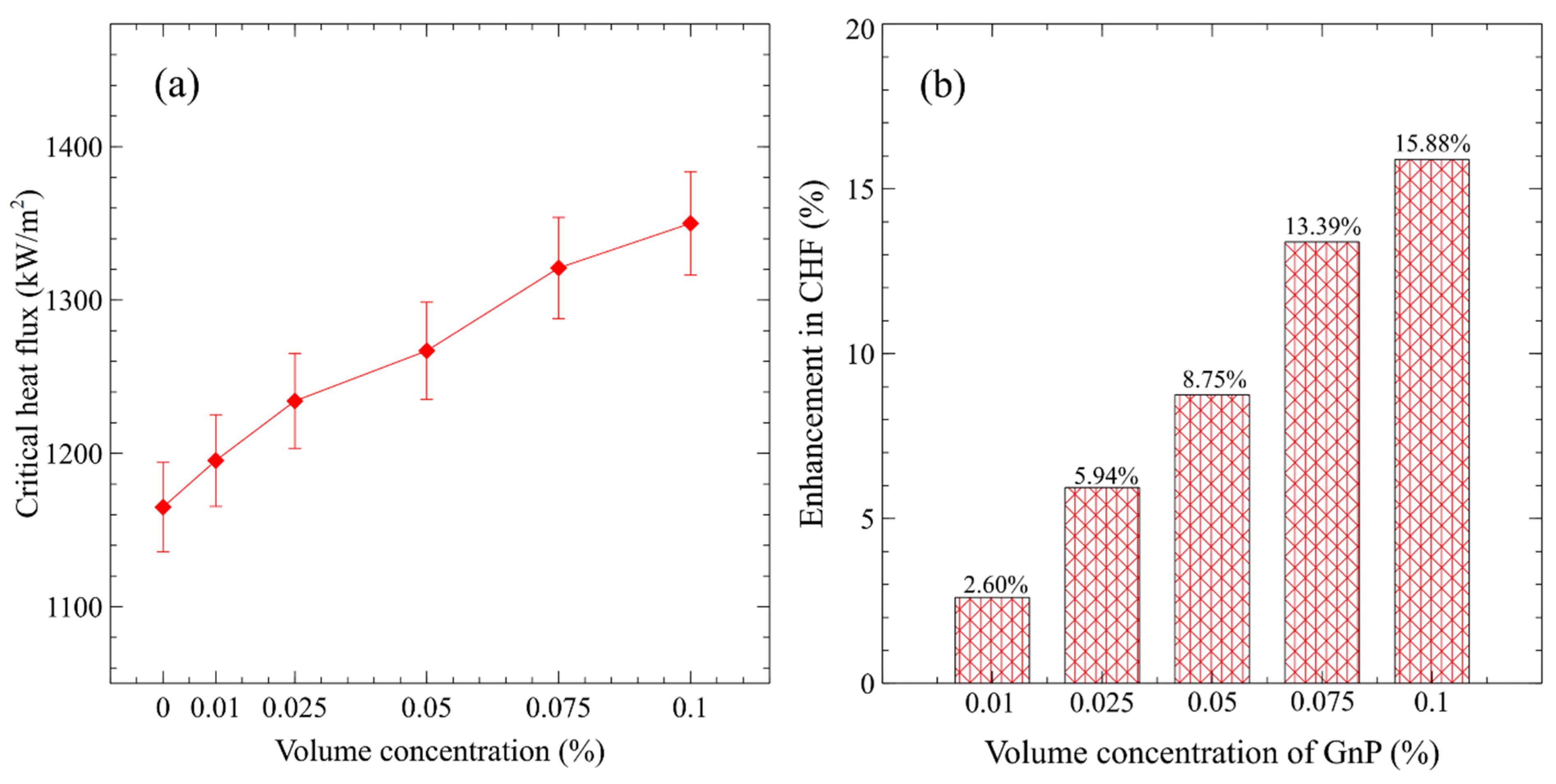


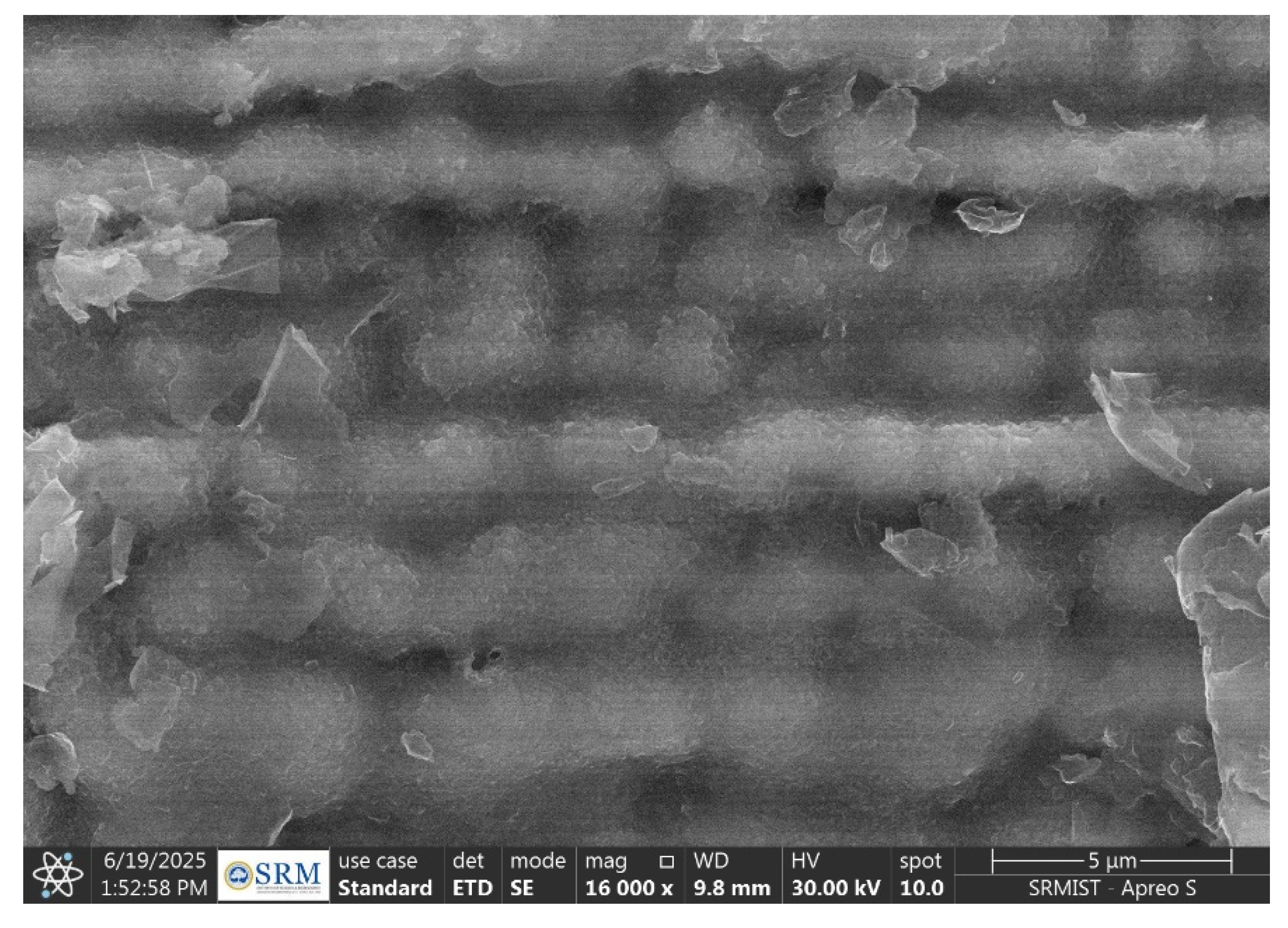
Disclaimer/Publisher’s Note: The statements, opinions and data contained in all publications are solely those of the individual author(s) and contributor(s) and not of MDPI and/or the editor(s). MDPI and/or the editor(s) disclaim responsibility for any injury to people or property resulting from any ideas, methods, instructions or products referred to in the content. |
© 2025 by the authors. Licensee MDPI, Basel, Switzerland. This article is an open access article distributed under the terms and conditions of the Creative Commons Attribution (CC BY) license (https://creativecommons.org/licenses/by/4.0/).
Share and Cite
Venkatraman, S.; Selvam, C. Experimental Study on the Enhancement of Pool Boiling Heat Transfer Characteristics of Water-Based Nanofluids with Graphene Nanoplatelets on Nichrome Wire. Thermo 2025, 5, 48. https://doi.org/10.3390/thermo5040048
Venkatraman S, Selvam C. Experimental Study on the Enhancement of Pool Boiling Heat Transfer Characteristics of Water-Based Nanofluids with Graphene Nanoplatelets on Nichrome Wire. Thermo. 2025; 5(4):48. https://doi.org/10.3390/thermo5040048
Chicago/Turabian StyleVenkatraman, Srinivasan, and Chandrasekaran Selvam. 2025. "Experimental Study on the Enhancement of Pool Boiling Heat Transfer Characteristics of Water-Based Nanofluids with Graphene Nanoplatelets on Nichrome Wire" Thermo 5, no. 4: 48. https://doi.org/10.3390/thermo5040048
APA StyleVenkatraman, S., & Selvam, C. (2025). Experimental Study on the Enhancement of Pool Boiling Heat Transfer Characteristics of Water-Based Nanofluids with Graphene Nanoplatelets on Nichrome Wire. Thermo, 5(4), 48. https://doi.org/10.3390/thermo5040048






